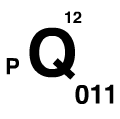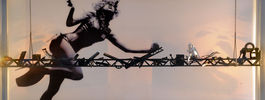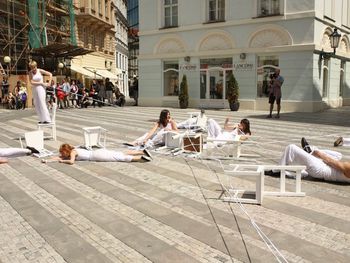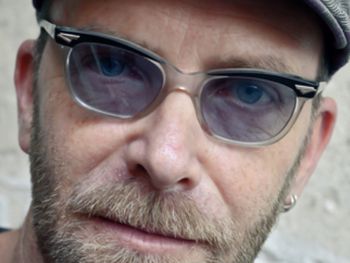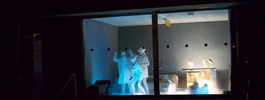The Georgian national exposition presents the works of 12 women scenographers manifesting the general characteristics of contemporary Georgian theater.
In the 19th and 20th centuries, Georgian theater was the protagonist of the national idea and the country’s political and social processes. In view of the new political and cultural reality of the 21st century, the theater now faces new challenges. The process of searching for a new identity extends to all levels of intellectual life, as the individual’s personal and gender identity has been transformed along with political identity. These processes manifest themselves in the specifics of composition, performance space, time modeling, and the dramatic interpretation of material and colors. In some of these works, this crisis of identity is felt in the images of spiritual and physical suffering, division, self-irony, dreaming, and the fragmented, mosaic or compressed and restrained space that originates from the recent conflicts and unresolved political and social problems; in other works, the grotesque is substituted to aestheticism and glamour as an ideal counterweight to disharmonic reality. Behind the negation of reality, pain, suffering and frustration, we can see a world at the edge of self-discovery. The artistic fabric of the women’s designs has been woven using archetypal symbols and basic colors, which are sporadic but full of vital energy. This results in the impression that, in the depths of spirituality and culture, a process of transformation and renewal is taking place. The National Pavilion of Georgia – “The Woman’s Voice” – is the “area” where the virtual unity of stage designers creates a unified panorama through the synthesis of visual imagery and music, consisting of real and virtual artifacts. Recordings of scenographic works/performances will be presented on screens along with video art inspired by the women’s theater designs. The exposition embraces the specifics of the exhibition space. Doors open in three directions, thus enhancing the flow of the audience, which symbolically reflects the geopolitical specificity of Georgia. At the same time, the openness of the architectural space opposes the pavilion design, which approaches the “black box” aesthetics. Darkened windows and black panel structures are designed to create a sense of inwardness. Taken as a whole, this creates the metaphor of ambivalence typical for the political and mental situation of a transition period. The music at the exposition is also ambiguous and includes a combination of silence and sound – a mixture of music and noise. The “Woman’s voice” is heard both directly and figuratively.
The exposition embraces the specifics of the exhibition space. Doors open in three directions, thus enhancing the flow of the audience, which symbolically reflects the geopolitical specificity of Georgia. At the same time, the openness of the architectural space opposes the pavilion design, which approaches the “black box” aesthetics. Darkened windows and black panel structures are designed to create a sense of inwardness. Taken as a whole, this creates the metaphor of ambivalence typical for the political and mental situation of a transition period.
The music at the exposition is also ambiguous and includes a combination of silence and sound – a mixture of music and noise. The Woman’s voice is heard both directly and figuratively.
- თამარა ოხიკიან (Tamara Okhikyan)
* 1985, Tbilisi
Specialization: costume designer, scenographer, visual artist
Education: Tbilisi State Academy of Arts, BA graphic design, Faculty of Media Art, 2008. MA, Faculty of Visual Arts, field of scenography, 2010
Collaboration with theatres: Music and Drama State Theatre / Tbilisi/, Royal District Theatre/ Tbilisi/, V. Gunia Poti State Drama Theatre, Chiatura State Drama Theatre, Batumi State Drama Theatre /Ajara AR/
Additional information: Tbilisi State Academy of Arts, BA graphic design, 2008; MA in scenography, 2010. Scenographer at the Poti Drama Theatre; collaborates with numerous theatres. Participated in the PQ'11 Student Section and Scenofest.
- ეკატერინე სოლოღაშვილი (Ekaterine Sologashvili)
* 1971, Tbilisi
Specialization: costume designer, scenographer, visual artist
Education: Nikoladze State Art School, Faculty of Fine Arts (1988-1992); Shota Rustaveli State University of Theatre and Film, Qualification Scenography (1992-1998), MA (2007).
Collaboration with theatres: Teacher – Shota Rustaveli State Drama Theatre, Basement Theatre, Puppets State Theatre of Tbilisi, Free Theatre, M. Tumanishvili Cinema Actor Theatre, N. Dumbadze State Central Children’s Theatre, Sukhumi Theatre of the Young
Teaching activities: Shota Rustaveli State University of Theatre and Film, Drama Faculty, Field of Scenography, 2001- 2005
Additional information: Rustaveli State University of Theatre and Film, 1998. MA, 2007. Collaborates with numerous theatres. Has teaching experience. Participated in the PQ'07 Student Section.
- Nino Chitaishvili
* 1965, Tbilisi
Specialization: teacher, costume designer, scenographer
Education: Tbilisi State Academy of Arts, Scenography, 1989
Collaboration with theatres: Tbilisi Opera and Ballet, Marjanishvili, Tumanishvili and Basement Theatres, Hague Theatergezelschap Mimessis
Teaching activities: Tbilisi State Academy of Arts, Ilia State University
Participation in other important exhibitions: Georgian scenography, Pierre Cardin's space, Paris, 2010.
Additional information: Tbilisi State Academy of Arts, 1989. Head Designer of the Tbilisi Youth Theatre. Collaborates with opera and drama theatres in Georgia and abroad. Has taken part in international exhibitions.
- Nino Chubinishvili
* 1969, Tbilisi
Specialization: costume designer, fashion designer, visual artist
Education: Stage and costume design at Tbilisi State Academy of Arts, 1996; post-graduate program in international fashion design at Institute Francais de la Mode, Paris, 2005-2006
Collaboration with theatres: Rustaveli State Drama Theatre, Tbilisi Opera and Ballet State Theatre.
Participation in other important exhibitions: Georgian scenography, Pierre Cardin's space, Paris, 2010; Born in Georgia, Cobra Museum, Amsterdam, 2009
Awards: Grand Prix, “Russian Silouette” international fashion contest, Moscow, 2001.
Additional information: Tbilisi State Academy of Arts, 1996; post-graduate program in international fashion design at Institute Francais de la Mode, 2006. Independent artist, collaborates with theatres; participant of international exhibitions.
- Manana Gunia
* 1973, Tbilisi
Specialization: costume designer, scenographer, visual artist
Education: Tbilisi State Academy of Arts, MFA in scenography (1990–1996), post-graduate diploma in film and TV scenography (1996-1998); Academy of Fine Arts of Florence, post-graduate studies in virtual scenography (2002).
Collaboration with theatres: Luigi Cherubini State Conservatory of Music (Florence, Italy), Tbilisi State Conservatory, Theatre of the S. Rustaveli Georgian State University of Theatre and Film (Tbilisi, Georgia), Marjanishvili State Drama Theatre (Tbilisi, Georgia), Rustavi Municipal Childrens’ Theatre (Rustavi, Georgia).
Teaching activities: Professor of 3D Scenography (masterclasses) The Accademia del Teatro alla Scala - Course of Information technology applied to scenography (Milan, Italy) 2004-2005, Professor of Costum Design, S. Rustaveli Theatre and Film Georgian State University (Tbilisi, Georgia)
Awards: 2001 - Fiorino d’Oro at the 20th “Florence Award”, “Mario Conti” Florence Cultural Center-Europe for best multimedia work (Florence, Italy)
Additional information: Tbilisi State Academy of Arts, 1996; post-graduate diploma in film & TV scenography, 1998; Academy of Fine Arts of Florence, post-graduate studies, 2002. Collaborates with various theatres. Designer of the Georgian Student Pavilion at PQ'07 and PQ'11.
- Anna Kalatozishvili
* 1967, Tbilisi
Specialization: costume designer, scenographer, visual artist
Education: Tbilisi State Academy of Arts, Department of Theatre Designing, 1984–1992. University of Applied Arts, Master of Arts, Vienna, Austria, 1993–1995.
Collaboration with theatres: Shota Rustaveli State Drama Theatre, Marjanishvili State Academic Drama Theatre, Tbilisi Opera and Ballet State Theatre, Akhmeteli Theatre, Royal Distirct Theatre, Batumi Music Center, Tumanishvili Film Artists Theatre, FTB (Bozzen, Italy); Young Generation Theatre, Theatre “Veriko”.
Teaching activities: Shota Rustaveli State University of Theater and Cinema, lecturer in history of theatre design (theory and practice), 2000-2003. Tbilisi State Academy of Arts, teacher of colour studies, 1998-2000.
Participation in other important exhibitions: Internationale Werkstattwoche fur Maler und Grafiker, Luben, Germany; Artist’s International Symposium and Exhibition, Germany; Lomonosov Palace, St. Petersburg; Kultur Smelde Gallery, Vienna; St. Martin’s College of Art and Design, London.
Continuing collaboration with directors: Otar Ioseliani, Mikhael Tumanishvili, Yuri Posokhov
Additional information: Tbilisi State Academy of Arts, 1992. MA, University of Applied Arts, Vienna, 1995. Works as a theatre and movie designer in Georgia and abroad. Has participated at international exhibitions.
- Nino (Nutsa) Khidasheli
* 1967, Tbilisi
Specialization: actor, costume designer, puppet designer, art historian, fabric restorator
Education: Tbilisi State Academy of Arts, Architecture and Theory of Art, 1986-1992. Trainings, Department of Protection of Historical Monuments, Georgian National Museum, historical fabrics, textile and embroidery restoration, 1987-1989; Toidze Art School, 1984-198
Collaboration with theatres: Basement Theater (Tbilisi), Russian State Youth Theatre (Tbilisi), Tumanishvili Film Artists Theatre (Tbilisi), A. Griboedov Russian State Drama Theatre (Tbilisi), Theatre of Tales (Tbilisi), Experimental Puppet Theatre / Studio DARANI (Tbilisi)
Teaching activities: Shota Rustaveli State University of Theater and Cinema, teacher of puppet-making technologies, 1998-2001.
Additional information: Tbilisi State Academy of Arts, Architecture and Theory of Art, 1992. Collaborates with puppet and drama theatres as a costume designer.
- Nino Kitia
* 1982, Tbilisi
Specialization: costume designer, scenographer
Education: V. Chabukiani School of Choreography, 1992-2000; N. Dumbadze Professional State Youth Theatre, Actor-Director Studio, 1992-1998; Tbilisi State Academy of Arts, Degree in Stage and Costume Design, 2000-2006
Collaboration with theatres: Georgia: Dumbadze Professional State Youth Theatre, Marjanishvili State Academic Drama Theatre, Tumanishvili Film Artists Aheatre, Music and Drama State Theatre, Gorgi State Drama Theatre. Russian Federation: Yekaterinburg Drama Theatre, Serpukhov Drama Theatre.
Additional information: Chabukiani School of Choreography, 2000; Professional State Youth Theatre, Actor-Director Studio, 1998; Tbilisi State Academy, 2006. Collaborates with music and drama theatres in Georgia and the Russian Federation.
- Teo Kuhkianidze
* 1980, Tbilisi
Specialization: costume designer, scenographer, event designer
Education: Tbilisi Ekvtime Takaisvili State University of Culture and Arts, event design, 2004. Shota Rustaveli Theatre and Film State University of Georgia, 2004-2006.
Collaboration with theatres: Kutaisi State Drama Theatre, Kutaisi State Theatre of Puppet, Tbilisi Liberty Theatre, Gori Drama Theatre, Chiatura Drama Theatre and Batumi Drama Theatre.
Additional information: Tbilisi State University of Culture and Arts, event design, 2004. Rustaveli Theatre and Film State University of Georgia, 2006. Currently post-graduate student. Collaborates with puppet and drama theatres.
- Anano Mosidze
* 1975, Tbilisi
Specialization: costume designer, visual artist, fashion designer, visual artist
Education: Tbilisi State Academy of Arts, Faculty of Design, Fashion Design, 1997.
Collaboration with theatres: Tbilisi Music and Drama State Theatre, Tumanishvili Film Artists Theatre (Tbilisi), National Theater of Rijeka, Croatia.
Teaching activities: Ivane Javakhishvili State University, Department of Arts, 2003-2005; Sulkhan-Saba Orbeliani Institute of Pedagogy, Department of Arts, 2000-2002.
Continuing collaboration with directors: David Doiashvili
Additional information: Tbilisi State Academy of Arts, 1997. Has worked at the Tbilisi Music and Drama State Theatre as a costume designer since 2005. Takes part in international exhibitions.
- Anna Ninua
* 1979, Tbilisi
Specialization: costume designer, scenographer
Education: Tbilisi State Academy of Arts, Fine Arts Faculty, Scenography, 1997-2004.
Collaboration with theatres: Sokhumi State Theatre (since 2004), Shota Rustaveli State Drama Theatre, Royal District Theatre, Music and Drama Theatre, A. Griboedov Russian State Drama Theatre (Tbilisi).
Teaching activities: Tbilisi State Academy of Arts, Scenography, Fine Arts Faculty.
Continuing collaboration with directors: Robert Sturua
Additional information: Tbilisi State Academy of Arts, 2004. Sokhumi State Theatre, chief artist. Collaborates with music and drama theatres in Georgia and abroad.
- Nino Surguladze
* 1971, Tbilisi
Specialization: costume designer
Education: Tbilisi Academy of Fine Arts, TV & Film Set Designer, 1997; ETSU and NYU Tisch School of Arts, Stage Design, 1994.
Collaboration with theatres: Marjanishvili State Academic Drama Theatre
Continuing collaboration with directors: Levan Tsuladze
Additional information: Tbilisi Academy of Fine Arts, TV & Film Set Designer, 1997; ETSU and NYU Tisch School of Arts, Stage Design, 1994. Costume designer at Marjanishvili State Theatre; has worked as a film production designer and has held several personal exhibitions.

